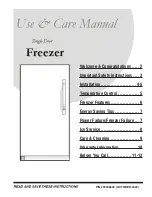
~ 64 ~
4.6 Power failure
❖
Max storage time in case of malfunctions: s. chapter T
ECHNICAL DATA
.
❖
In case of power failure, the current settings will be secured and maintained.
❖
If the appliance is supplied with power again, it continues to work with the
settings adjusted before.
In the event of an unpredictable
power failure
:
➢
reduce the opening frequency of the doors.
➢
do not put any new food in the appliance to avoid a rapid rise of the
temperature inside the appliance.
In the event of a predictable power failure
, you can activate the F
AST
F
REEZING
M
ODE
and decrease the temperature of the freezer as a precautionary
measure to set the appliance to the lowest temperature (= strongest cooling) so
that it is maximally cooled at the time of the power failure.
NOTICE!
In an event of a power failure,
do not open
the door so your
food can remain in the appliance for -x- hours (-x-: see chapter
TECHNICAL
DATA
).
4.7 The freezer
WARNING!
Do not eat food which is still frozen. Children should not
eat ice-cream straight from the freezer. The coldness can cause injuries
in the mouth.
WARNING!
Contact with frozen food, ice and metal components in the
freezer can cause injuries similar to burns.
CAUTION!
Do not touch the extremely cooled surfaces with wet or
damp hands, because your skin may stick on these surfaces.
CAUTION! Do not store any bottled or canned beverages (neither
still nor carbonated)
in the freezer as their containers could explode.
The freezer is intended
for long-term storage
of food. Please observe the advice
for max. storage time on the packaging of frozen food products. Do not refreeze
defrosted food.
❖
Protect fresh food you want to freeze using aluminium foil, cling film, air and
water tight plastic bags, polyethylene containers or other suitable plastic
containers with a lid.
















































